RiceSAP: An Efficient Satellite-Based AquaCrop Platform for Rice Crop Monitoring and Yield Prediction on a Farm- to Regional-Scale
Abstract
1. Introduction
2. Materials and Methods
2.1. Study Area and Field Survey
2.2. Satellite-Derived Products
2.2.1. TERRA MODIS-LST to Derive Air Temperatures
2.2.2. FY-2 IR Rainfall to Derive Accumulated Rainfall
2.2.3. Sentinel-2 NDVI Product for CC Recalibration
2.3. AquaCrop Processing
2.3.1. Input Parameters
2.3.2. AquaCrop Simulaltion Scheme
2.3.3. Canopy Cover Recalibration Methodology
2.4. Rice Smart Agriculture Platform (RiceSAP)
3. Results
3.1. AquaCrop Processing Performance with the Proposed Algorithm
3.2. RiceSAP Applicability and Field Variation Performance
4. Discussion
5. Conclusions
Author Contributions
Funding
Acknowledgments
Conflicts of Interest
References
- Food and Agriculture Organization of the United Nations. Available online: http://www.fao.org/3/a-i6398e.pdf (accessed on 21 March 2020).
- Rehman, A.; Shaikh, Z. Smart Agriculture. In Application of Modern High Performance Networks; Zubairi, J.A., Ed.; Bentham Science Publisher Ltd.: Sharjah, UAE, 2009; pp. 120–129. [Google Scholar]
- Atzberger, C. Advances in Remote Sensing of Agriculture: Context Description, Existing operational monitoring systems and major information needs. Remote Sens. 2013, 5, 949–981. [Google Scholar] [CrossRef]
- Robertson, M.J.; Kirkegaard, J.A. Water-use efficiency of dryland canola in an equi-seasonal rainfall environment. Aust. J. Agric. Res. 2005, 56, 1373–1386. [Google Scholar] [CrossRef]
- Rudorff, B.F.T.; Batista, G.T. Spectral response of wheat and its relationship to agronomic variables in the tropical region. Remote Sens. Environ. 1990, 31, 53–63. [Google Scholar] [CrossRef]
- Doraiswamy, P.C.; Moulin, S.; Cook, P.W.; Stern, A. Crop yield assessment from remote sensing. Photogramm. Eng. Rem. 2003, 69, 665–674. [Google Scholar] [CrossRef]
- Majd, A.S.; Bleiweiss, M.P.; Dubois, D.; Shukla, M.K. Estimation of the fractional canopy cover of pecan orchards using Landsat 5 satellite data, aerial imagery, and orchard floor photographs. Int. J. Remote Sens. 2013, 34, 5937–5952. [Google Scholar] [CrossRef]
- Ferencz, C.; Bognar, P.; Lichtenberger, J. Crop yield estimation by satellite remote sensing. Int. J. Remote Sens. 2004, 25, 4113–4149. [Google Scholar] [CrossRef]
- Yang, C.; Everitt, J.H.; Bradford, J.M.; Escobar, D.E. Mapping grain sorghum growth and yield variations using airborne multispectral digital imagery. Trans. ASAE 2000, 43, 1927–1938. [Google Scholar] [CrossRef]
- Di Paola, A.; Valentini, R.; Santini, M. An overview of available crop growth and yield models for studies and assessments in agriculture. J. Sci. Food Agric. 2016, 96, 709–714. [Google Scholar] [CrossRef]
- Homma, K.; Maki, M.; Hirooka, Y. Development of a rice simulation model for remote sensing (SIMRIW-RS). J. Agric. Meteorol. 2017, 73, 9–15. [Google Scholar] [CrossRef]
- Mass, S.J. Use of remotely-sensed information in agricultural crop growth model. Ecol. Modell. 1988, 41, 247–268. [Google Scholar] [CrossRef]
- Hoogenboom, G.J.; White, J.W.; Messina, C.D. From genome to crop: Integration through simulation modelling. Field Crops Res. 2004, 90, 145–163. [Google Scholar] [CrossRef]
- Rauff, K.O.; Bello, R. A review of crop growth simulation models as tools for agricultural meteorology. Agric. Sci. 2015, 6, 8. [Google Scholar] [CrossRef]
- Kasampalis, D.A.; Alexandridis, T.K.; Deva, C.; Challinor, A.; Moshou, D.; Zalidis, G. Contribution of remote sensing on crop models: A review. J Imaging 2018, 4, 52. [Google Scholar] [CrossRef]
- Food and Agriculture Organization of the United Nations. Review of the Available Remote Sensing Tools, Products, Methodologies and Data to Improve Crop Production Forecasts; FAO: Rome, Italy, 2017; pp. 14–19. [Google Scholar]
- Ramirez-Villegas, J.; Watson, J.; Challinor, A.J. Identifying traits for genotypic adaptation using crop models. J. Exp. Got. 2015, 66, 3451–3462. [Google Scholar] [CrossRef]
- Food and Agriculture Organization of the United Nations. AquaCrop or FAO. Available online: http://www.fao.org/aquacrop/overview/whatisaquacrop/en/ (accessed on 21 March 2020).
- Sarangi, A. Crop Yield Simulation Using AquaCrop Model under Rainfed and Irrigated Conditions; Water Technology Centre, Indian Agricultural Research Institute Library Avenue: New Delhi, Indian, 2012; pp. 50–60. [Google Scholar]
- Todorovic, M.; Albrizio, R.; Zivotic, L.; Abi Saab, M.; Stöckle, C.; Steduto, P. Assessment of AquaCrop, CropSyst, and WOFOST Models in the Simulation of Sunflower Growth under Different Water Regimes. J. Agron. 2009, 101, 509–521. [Google Scholar] [CrossRef]
- Food and Agriculture Organization of the United Nations or FAO. Available online: http://www.fao.org/land-water/land/land-governance/land-resources-planning-toolbox/category/details/en/c/1027490/ (accessed on 21 March 2020).
- Vanuytrecht, E.; Raes, D.; Steduto, P.; Hsiao, T.C.; Fereres, C.H.; Lee, K.H.; Vila, M.G.; Moreno, P.M. AquaCrop: FAO’s crop water productivity and yield response model. Environ. Modell. Softw. 2014, 62, 351–360. [Google Scholar] [CrossRef]
- Food and Agriculture Organization of the United Nations. AquaCrop. Available online: https://digital.csic.es/bitstream/10261/180239/1/IntroAquaCrop_20190304.pdf (accessed on 21 March 2020).
- Marta, A.D.; Chirico, G.B.; Bolognesi, S.F.; Mancini, M.; D’Urso, G.; Orlandini, S.; De Michele, C.; Altobelli, F. Integrating Sentinel-2 imagery with AquaCrop for dynamic assessment of tomato water requirements in Southern Italy. Agronomy 2019, 9, 404. [Google Scholar] [CrossRef]
- Prathumchai, K.; Nagai, M.; Tripathi, N.K.; Sasaki, N. Forecasting Transplanted Rice Yield at the Farm Scale Using Moderate-Resolution Satellite Imagery and the AquaCrop Model: A Case Study of a Rice Seed Production Community in Thailand. Int. J. Geo-Inf. 2018, 7, 73. [Google Scholar] [CrossRef]
- Office of Agricultural Economics. Available online: http://www.oae.go.th/view/1/Home/EN-US (accessed on 21 March 2020).
- Allen, G.R.; Pereira, L.S.; Raes, D.; Smith, M. Crop Evapotranspiration-Guidelines for computing crop water requirements. FAO Irrig. Drain. Pap. 1998, 56, 78–86. [Google Scholar]
- Hargreaves, G.H.; Samani, Z.A. Reference crop evapotranspiration from temperature. Appl. Eng. Agric. 1985, 1, 96–99. [Google Scholar] [CrossRef]
- Veerakachen, W.; Raksapatcharawong, M. Daily monitoring of soil moisture in Thailand by FY-2E satellite. Kasetsart J. (Nat. Sci.) 2014, 48, 254–262. [Google Scholar]
- Raes, D.; Steduto, P.; Hsiao, T.C.; Fereres, E. Calculation Procedures. In AquaCrop Reference Manual, version 6.0–6.1; Food and Agriculture Organization of the United Nations: Rome, Italy, 2018. [Google Scholar]
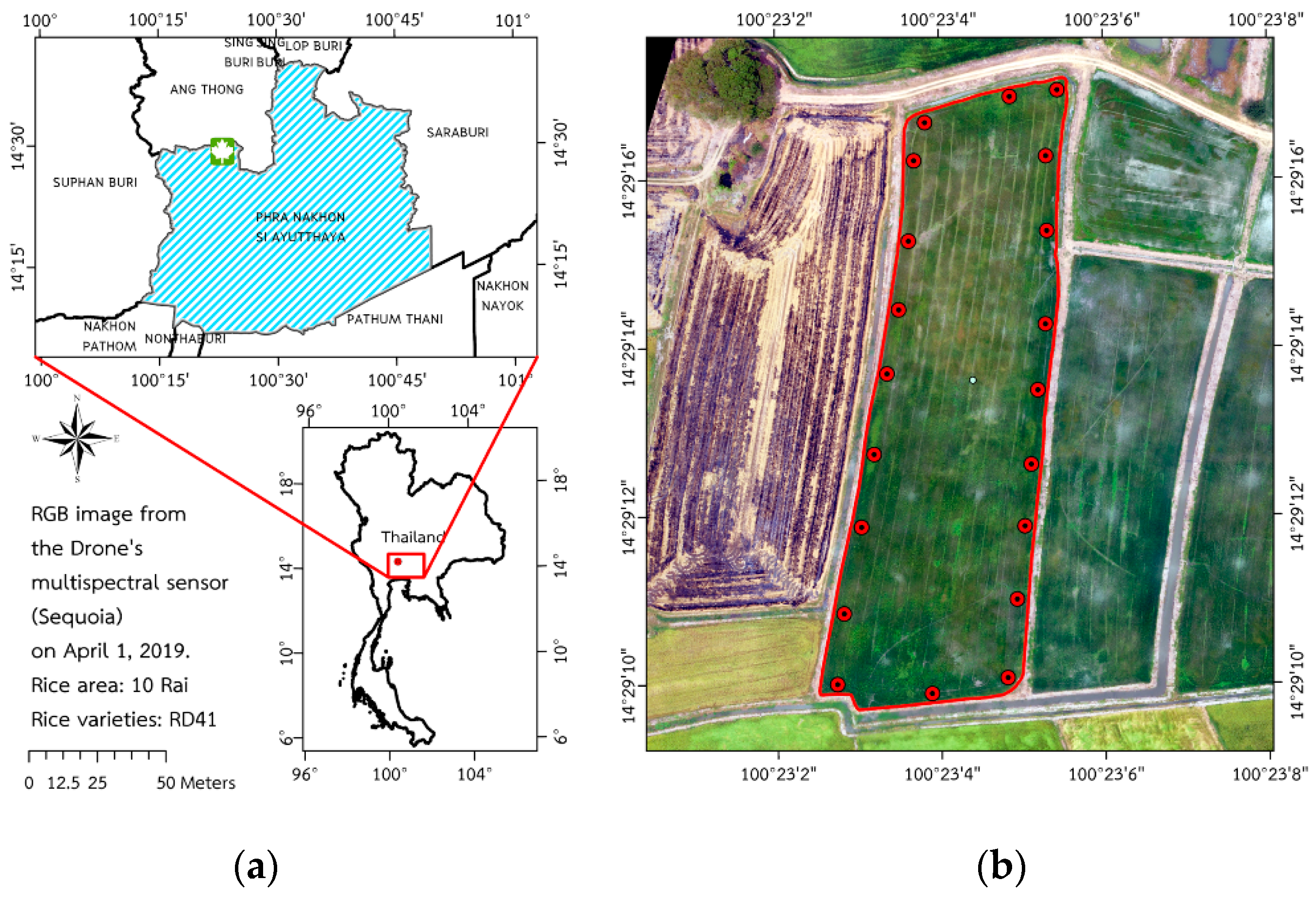

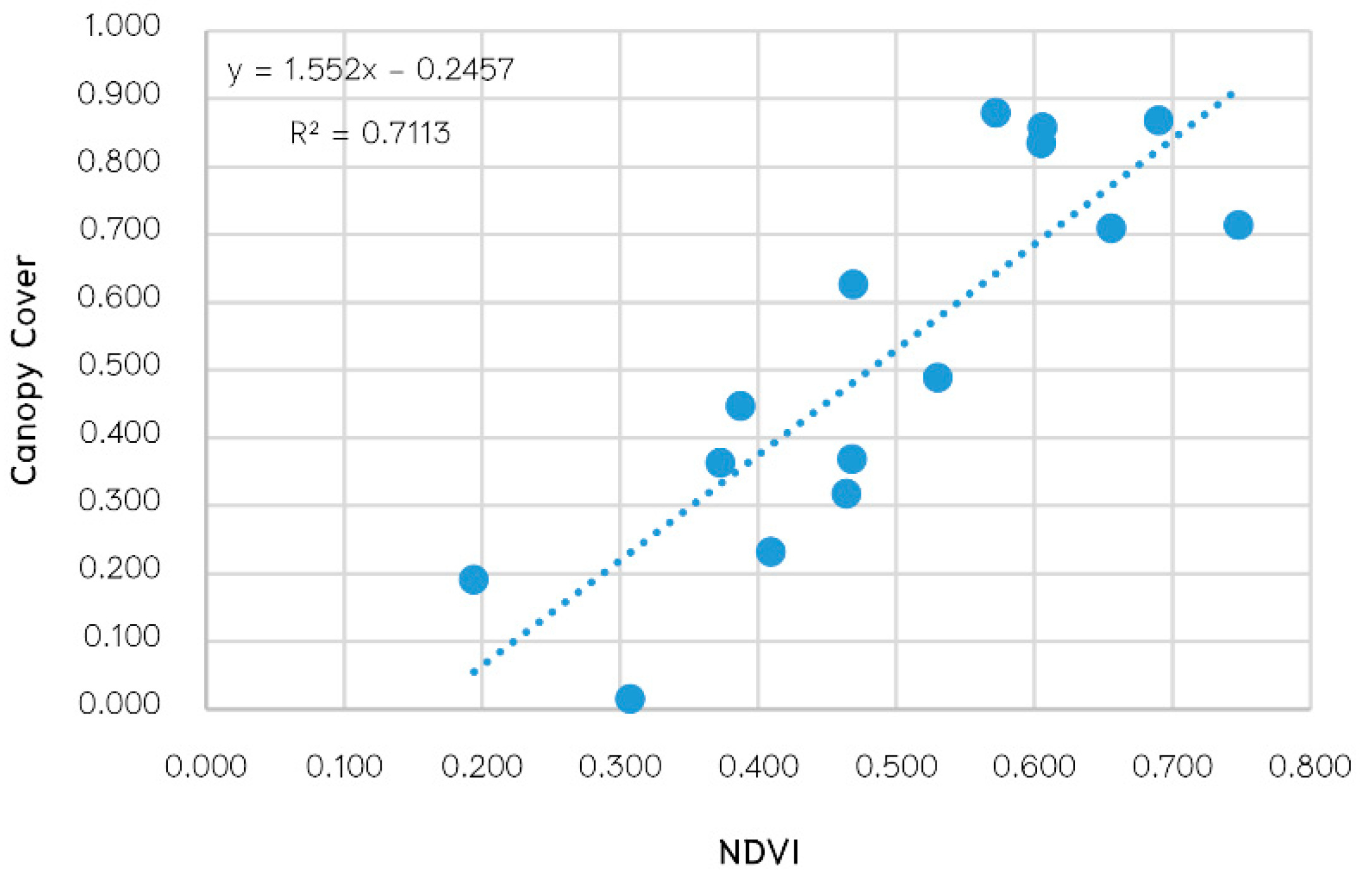
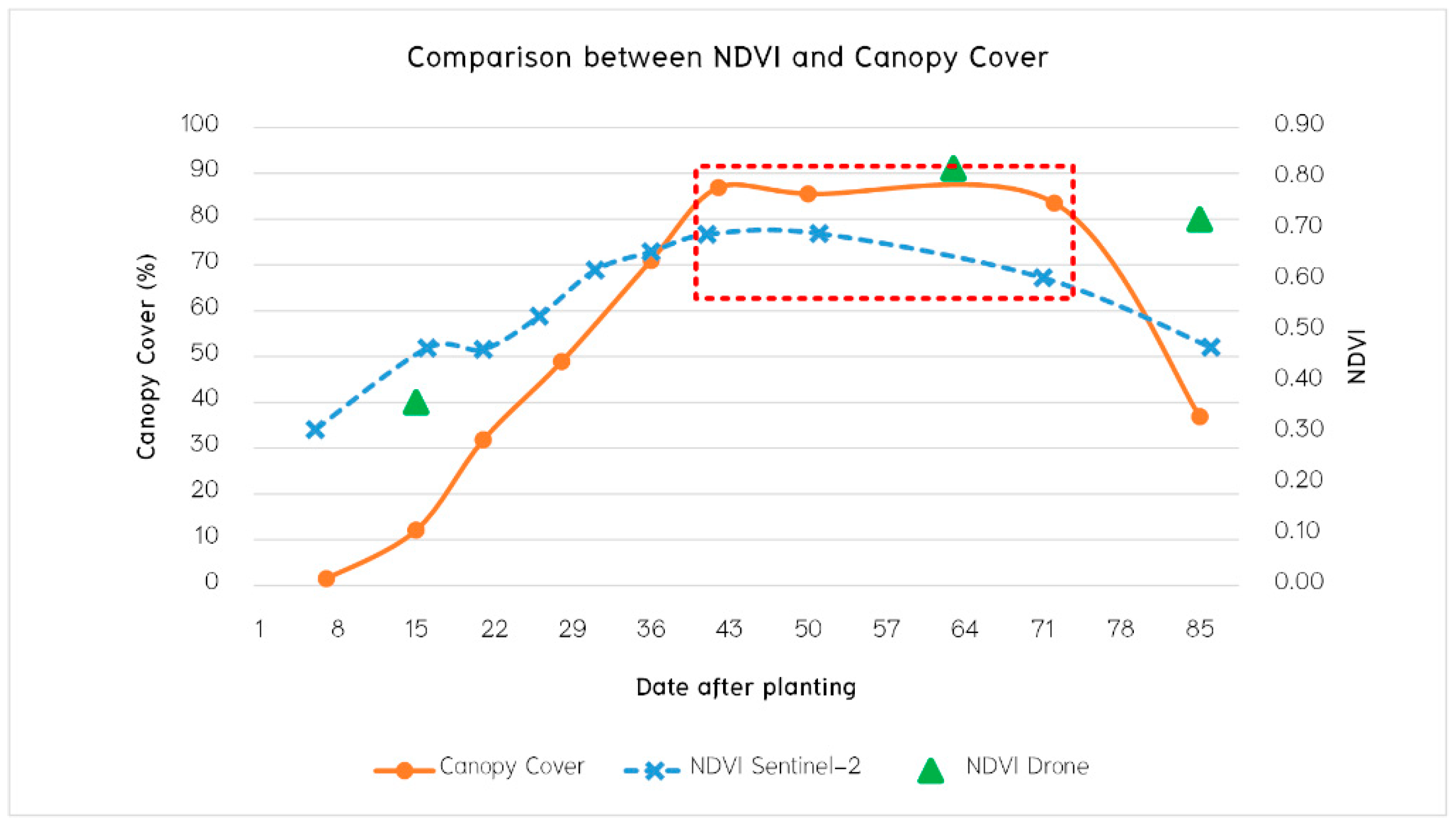
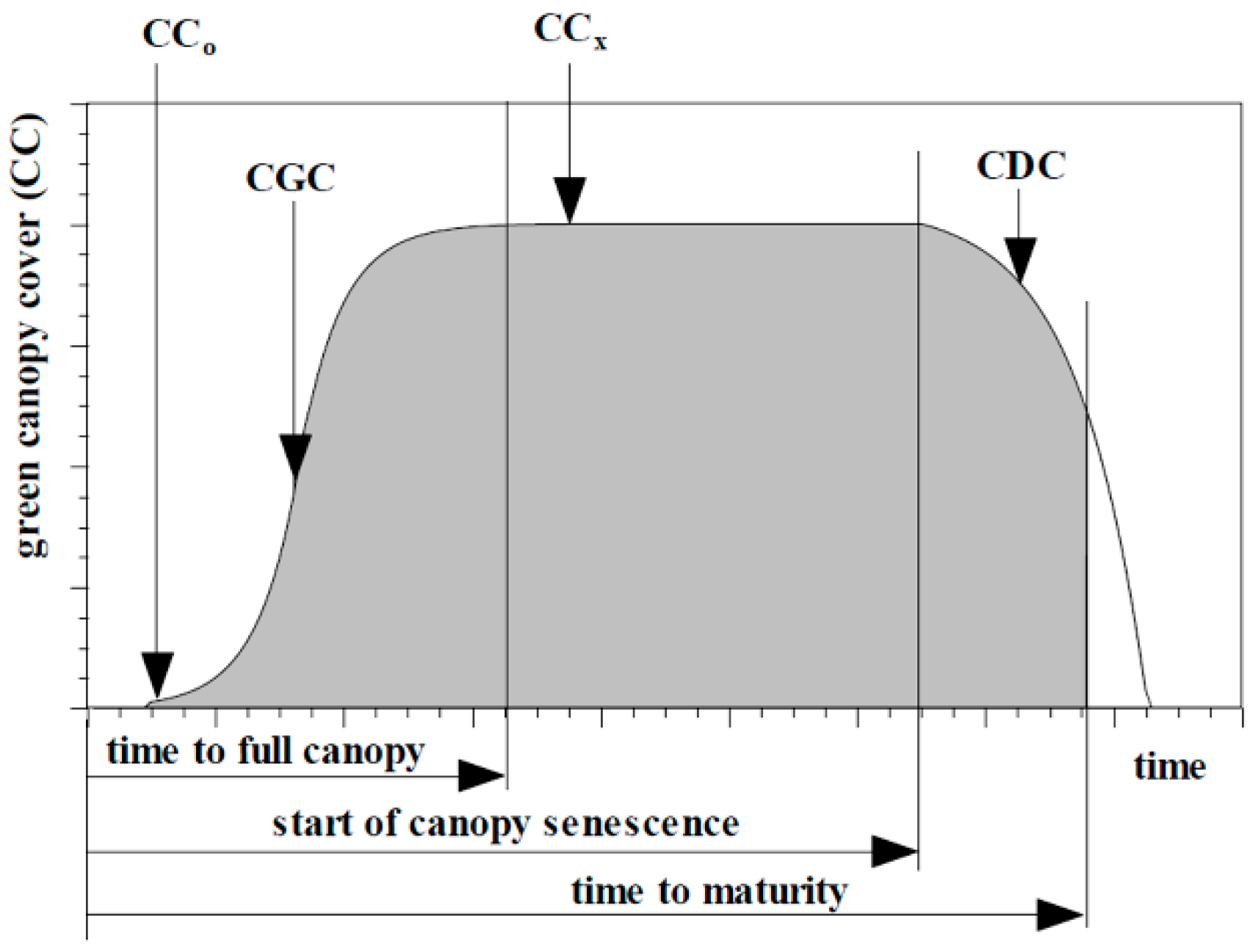
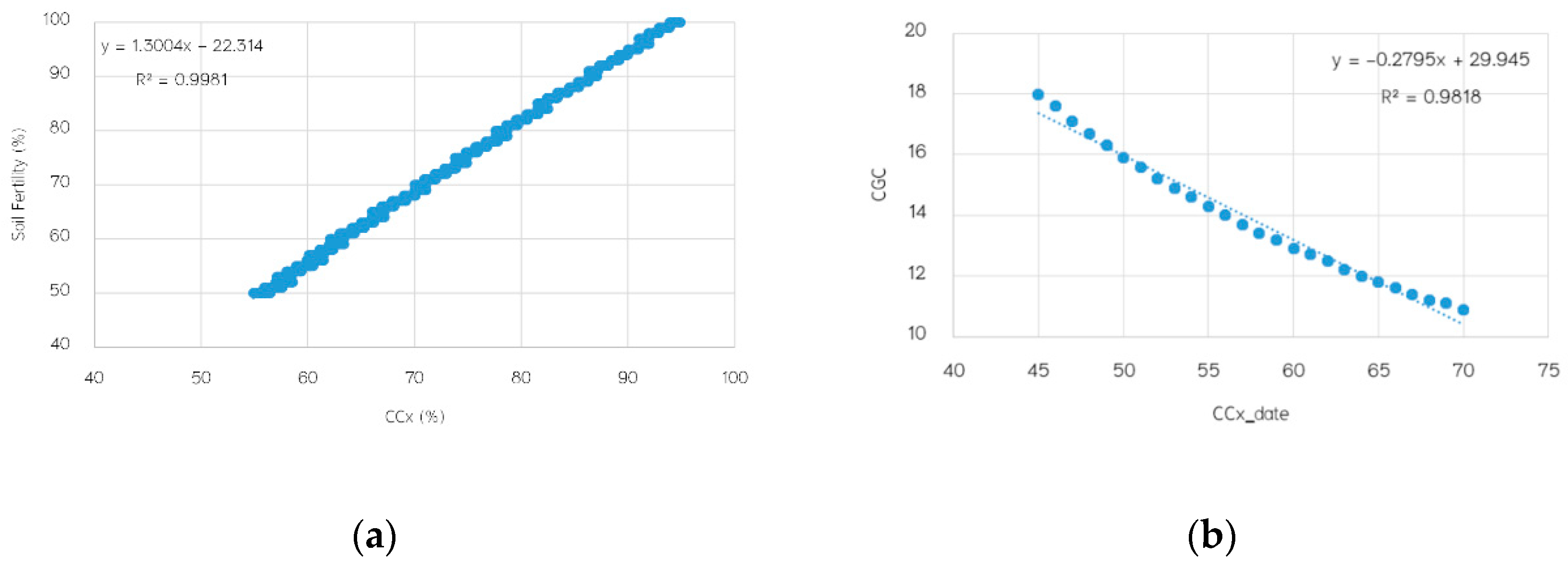

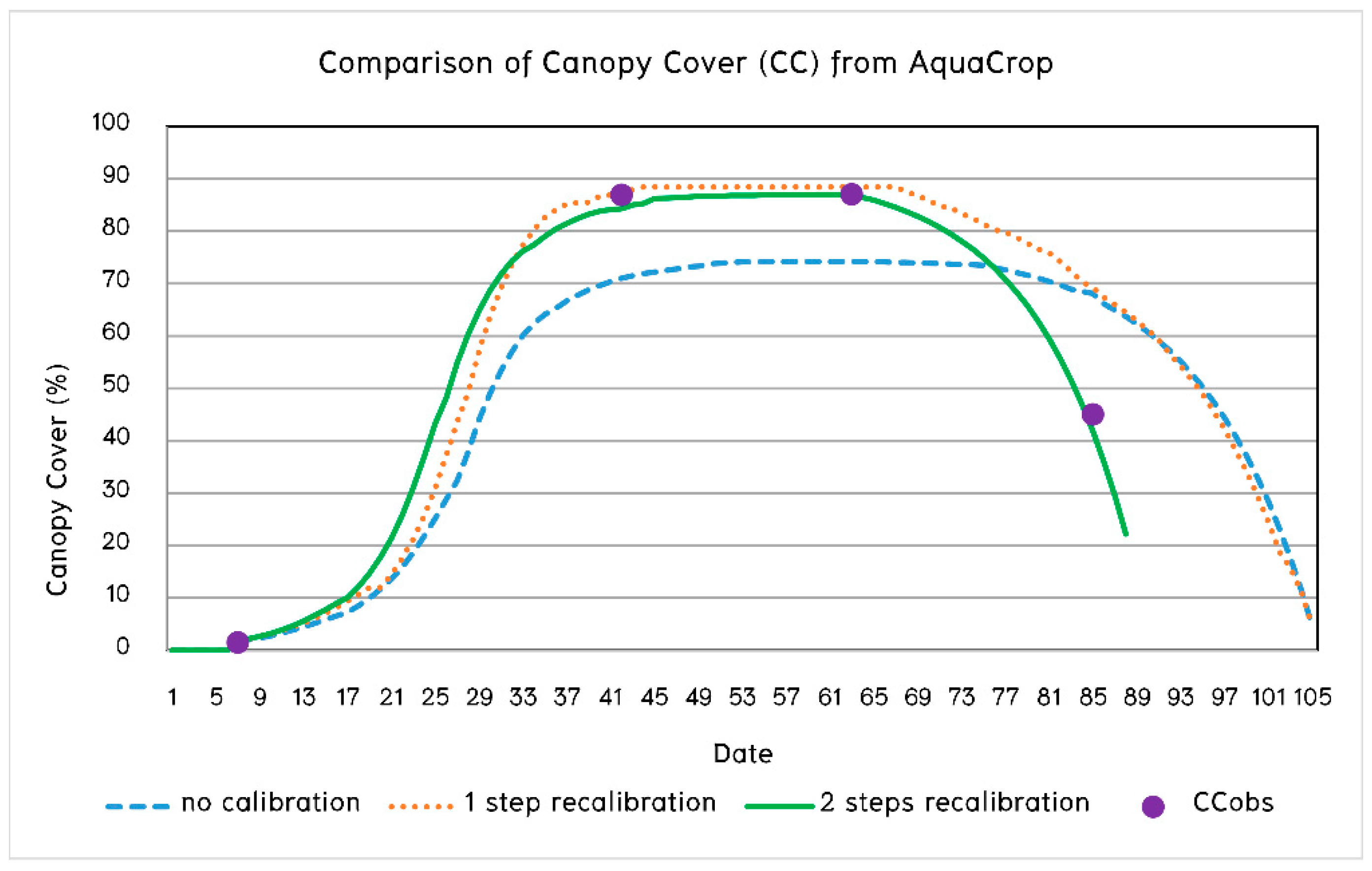

| Rice Stage | Photos Taken from the Site | Field Measurement | |||
|---|---|---|---|---|---|
| Drone | EC | CC | Yield | ||
| Transplanting (25 February, 25 days after sowing) | 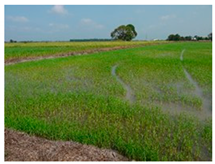 | √ | √ | √ | - |
| Flowering (9 April, 63 days after sowing) | 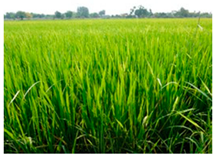 | √ | √ | √ | - |
| Harvest (1 May, 85 days after sowing) | 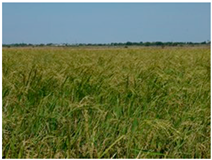 | √ | √ | √ | √ |
| Data Sources | Products | Resolution | Acquired Period |
|---|---|---|---|
| TERRA/MODIS | LST | 1 km | 2014–2017 |
| FY-2 IR1 | Rainfall | 5 km | 2014–2017 |
| TMD stations | Rainfall/temperture | - | 2014–2017 |
| SENTINEL-2 MSI | NDVI | 10 m | February–May 2019 |
| Temporal Resolution | Models | R2 |
|---|---|---|
| Daily | y = 0.567x | 0.11 |
| Dekadal | y = 0.3738x | 0.30 |
| Monthly | y = 0.7148x | 0.26 |
| Inputs | Parameters | Satellite Products |
|---|---|---|
| Climate | max/min air temperature and ET0 | TERRA/MODIS LST |
| Rainfall | FY-2 IR Rainfall | |
| Crop | initial values for crop response | Sentinel-2 NDVI |
| Management | soil fertility | Sentinel-2 NDVI |
| Datasets | No Recalibration | 1st Step Recalibration | 2nd Step Recalibration | |||
|---|---|---|---|---|---|---|
| Simulated Yield (ton/ha) | Prediction MAPE (%) | Simulated Yield (ton/ha) | Prediction MAPE (%) | Simulated Yield (ton/ha) | Estimation MAPE (%) | |
| Alpha I | 4.54 | 63.89 | 3.71 | 33.91 | 2.21 | 20.16 |
| Weather Station | 3.54 | 27.81 | 2.51 | 9.28 | 2.64 | 4.9 |
| Satellite derived | 3.55 | 27.92 | 2.34 | 15.48 | 3.12 | 12.67 |
| Dataset | Climatic Data | Year | Parameters |
|---|---|---|---|
| Planting | HRS5Y 1 | 2013–2017 | Alpha I |
| Full Canopy | RS1Y 2 + HRS5Y 1 | 2013–2017 & 2019 | Update Climatic data to RS1Y 2 from planting date to CCx date. Readjust CCx date, CGC and Soil Fertility |
| Harvesting | RS1Y 2 | 2019 | Update Climatic data to RS1Y 2 Readjust Senescence date, and Harvesting date. |
| User No. | Area (ha) | Observed Yield (ton/ha) | Planting | Full Canopy | Harvest | |||
|---|---|---|---|---|---|---|---|---|
| Simulated Yield (ton/ha) | Prediction MAPE (%) | Simulated Yield (ton/ha) | Prediction MAPE (%) | Simulated Yield (ton/ha) | Estimation MAPE (%) | |||
| 1 | 2.56 | 3.20 | 5.86 | 83.25 | 3.68 | 35.25 | 4.22 | 31.94 |
| 2 | 4.8 | 3.75 | 6.16 | 64.27 | 3.36 | 5.32 | 3.69 | 1.49 |
| 3 | 1.6 | 2.50 | 5.82 | 132.75 | 3.55 | 66.96 | 4.12 | 64.94 |
| 4 | 0.64 | 5.00 | 5.84 | 16.82 | 4.71 | 10.82 | 5.22 | 4.35 |
| 5 | 5.12 | 5.10 | 5.85 | 14.75 | 4.80 | 10.87 | 4.57 | 10.28 |
| 6 | 16 | 5.38 | 5.96 | 10.79 | 5.02 | 9.74 | 5.11 | 5.05 |
| 7 | 3.2 | 3.75 | 5.38 | 43.56 | 3.93 | 23.17 | 4.50 | 19.91 |
| 8 | 0.8 | 3.44 | 5.12 | 49.08 | 3.74 | 27.93 | 4.25 | 23.76 |
| 9 | 1.6 | 3.44 | 5.22 | 51.85 | 3.63 | 24.06 | 4.16 | 20.98 |
| 10 | 0.86 | 4.35 | 5.30 | 21.76 | 4.28 | 15.65 | 4.90 | 12.62 |
| 11 | 0.9 | 4.90 | 5.67 | 15.77 | 4.54 | 9.00 | 5.25 | 7.15 |
| 12 | 1.18 | 5.17 | 5.70 | 10.22 | 4.70 | 6.90 | 4.93 | 4.71 |
| 13 | 1.57 | 5.44 | 6.29 | 15.52 | 3.93 | 14.96 | 4.79 | 11.96 |
| 14 | 0.56 | 4.63 | 5.29 | 14.31 | 4.04 | 2.69 | 4.75 | 2.79 |
| 15 | 3.2 | 4.01 | 5.03 | 25.22 | 3.74 | 9.54 | 4.17 | 3.85 |
| 16 | 4 | 4.01 | 5.06 | 25.92 | 3.78 | 10.77 | 3.99 | 0.72 |
| 17 | 1.6 | 5.66 | 4.80 | 15.14 | 5.35 | 11.26 | 5.42 | 4.29 |
| 18 | 1.92 | 6.25 | 5.14 | 17.82 | 4.58 | 13.86 | 5.48 | 12.26 |
| 19 | 9.6 | 5.19 | 6.15 | 18.57 | 4.13 | 6.43 | 5.09 | 1.85 |
| 20 | 3.52 | 4.83 | 6.03 | 24.94 | 3.33 | 18.85 | 3.99 | 17.39 |
| Average | 33.62 | 16.70 | 13.11 | |||||
| SD | 30.60 | 14.38 | 14.91 | |||||
© 2020 by the authors. Licensee MDPI, Basel, Switzerland. This article is an open access article distributed under the terms and conditions of the Creative Commons Attribution (CC BY) license (http://creativecommons.org/licenses/by/4.0/).
Share and Cite
Veerakachen, W.; Raksapatcharawong, M. RiceSAP: An Efficient Satellite-Based AquaCrop Platform for Rice Crop Monitoring and Yield Prediction on a Farm- to Regional-Scale. Agronomy 2020, 10, 858. https://doi.org/10.3390/agronomy10060858
Veerakachen W, Raksapatcharawong M. RiceSAP: An Efficient Satellite-Based AquaCrop Platform for Rice Crop Monitoring and Yield Prediction on a Farm- to Regional-Scale. Agronomy. 2020; 10(6):858. https://doi.org/10.3390/agronomy10060858
Chicago/Turabian StyleVeerakachen, Watcharee, and Mongkol Raksapatcharawong. 2020. "RiceSAP: An Efficient Satellite-Based AquaCrop Platform for Rice Crop Monitoring and Yield Prediction on a Farm- to Regional-Scale" Agronomy 10, no. 6: 858. https://doi.org/10.3390/agronomy10060858
APA StyleVeerakachen, W., & Raksapatcharawong, M. (2020). RiceSAP: An Efficient Satellite-Based AquaCrop Platform for Rice Crop Monitoring and Yield Prediction on a Farm- to Regional-Scale. Agronomy, 10(6), 858. https://doi.org/10.3390/agronomy10060858




